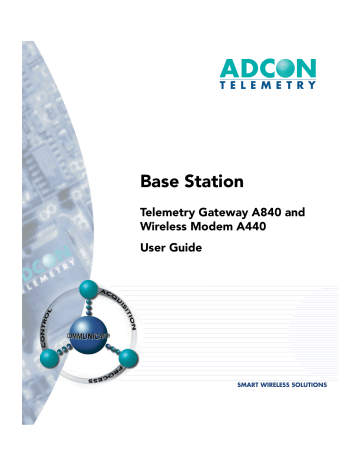
advertisement

Chapter 2. System Setup
9
Package Contents
Before proceeding to the installation of your base station, first verify that you received all of the following components:
• The A840 Telemetry Gateway
• The A440 Wireless Modem
• The 30 m (100 ft) connection cable between the A840 and the
A440 devices
• A power cord
• A twisted-pair ethernet cable (not used at this time, but included in the package)
• A serial null modem cable
• A whip antenna
If any of the above items is missing, contact your dealer.
Installation
The base station has two main components: an indoor unit (the
A840) and an outdoor unit (the A440).
10 CHAPTER 2
System Setup
Before proceeding with the installation, take a moment to plan your network. First, it is essential to realize the importance of selecting a good location for the base station. You must consider several factors, some of them quite contradictory, when you select this location:
• From a radio perspective, the height of the receiving antenna is essential: the higher the antenna, the greater the range of communication.
• The base station should be situated in the same building where the personnel managing the base station work, or at least spend some of their time.
• Places like cellars, near heat sources, or damp locations are not suitable.
• Geographically, it is better to have the base station in the center of the area where the RTUs will be installed.
• If you plan to use the base station as a server to allow other people to log in and get data, you have to make certain that a telephone line is available exclusively for this use.
• A telephone connection next to the PC is also very important for when you need technical support.
The communication distance you can achieve is directly proportional to the height of the receiving antenna. The propagation mode of the waves the Adcon system uses is basically the line of sight. Due to the curvature of the earth, on flat terrain, the maximum distance reached depends on the height of the receiver and of the measuring stations’ antennas. You can’t do much on the remote station side, but you have more options with the base sta-
CHAPTER 2
Installation
11 tion. Some typical examples of the achieved distances, under various conditions, are shown in Table 1.
Table 1. Communication Between Base Station and
A730MD/A733
Receiving antenna height
6 m (18 ft)
10 m (31 ft)
20 m (62 ft)
30 m (92 ft)
Typical distances achieved
5 km (3 miles)
8 km (5 miles)
16 km (10 miles)
24 km (15 miles)
The addIT RTU, however, uses low-power technology and was not designed to communicate over large distances. The typical “lineof sight” distance an addIT can communicate is 800 m (approximately half a mile). This is valid if the partner device is mounted on a 3 m mast (9 ft) and the addIT is mounted on a 30 cm mast (1 ft).
The above figures are estimates based on a great deal of experience with installing this kind of equipment and assume a typical height of 3 m (9 ft) for the antennas of the remote measuring stations. Similarly, ideal physical conditions are assumed for the terrain including a flat, open, nonurban environment.
What conclusions can be drawn from Table 1? Primarily, you can see the importance of having the base station antenna as high as possible. To gain antenna height, you have several options:
• Build a mast directly on the ground; however, a 30 m (100 ft) mast may not be a practical option.
• Set up a mast on a tall building (of course, it has to be the building where you want to have the base station).
• Install the base station in a building that is situated on a hill.
Note that the cable for the outdoor unit delivered with the system is 30 m long (about 100 ft). This means you must locate your indoor unit no more than 30 m from the outdoor unit. Lengthening the cable is not recommended, because the signal strength loss is significant.
advertisement
Related manuals
advertisement
Table of contents
- 7 Chapter 1. Introduction
- 9 Chapter 2. System Setup
- 9 Package Contents
- 9 Installation
- 12 Installing the Outdoor Unit
- 13 Installing the Indoor Unit
- 14 Initializing the Base Station
- 15 LED Indicators
- 15 Linux Mode
- 15 LAN and ACT
- 15 USR and RUN
- 16 Hermit Mode
- 17 Chapter 3. Advanced Functions
- 17 Administrative Tasks at the System Level
- 18 Stopping and Starting the telemetry gateway
- 19 Changing Passwords
- 20 Losing a Password
- 21 Software Upgrades
- 21 Upgrading the bootloader
- 22 To upgrade the system
- 23 Operations at the Application Level
- 23 Commands Accepted by the emu3ap Emulator
- 24 Configuration Commands
- 24 INSERT
- 24 REPLACE
- 24 DELETE
- 25 ROUTE
- 26 MASTER
- 26 EXTEND
- 26 SET Commands
- 27 SET TIME
- 27 SET FREQ
- 28 SET OWNID
- 28 SET SLOT
- 28 SET DELAY
- 29 SET ECHO/NOECHO
- 29 Data Commands
- 29 GETBLOCK
- 31 Administrative Commands
- 31 INSPECT
- 32 UPTIME
- 32 Direct Radio Commands
- 34 REQUEST
- 35 RSETIO
- 36 ANALOG
- 37 RBLIST
- 38 Error Messages
- 39 Frame Types
- 39 The A730MD frames
- 42 The A720 (addIT) Frames
- 43 The A723 (addIT series 3) Frames
- 45 The A733 (addWAVE) Frames
- 48 Frame Parsing Example